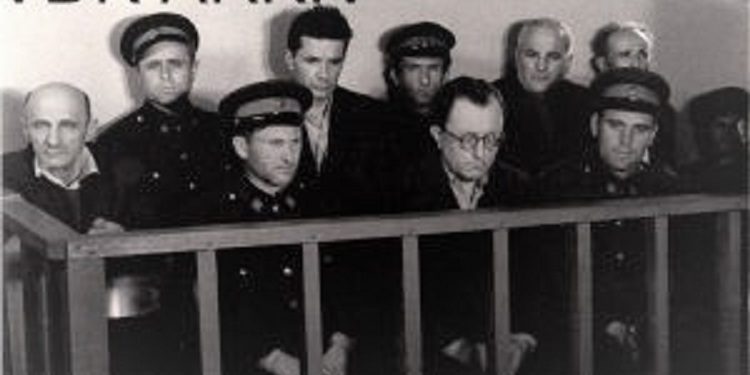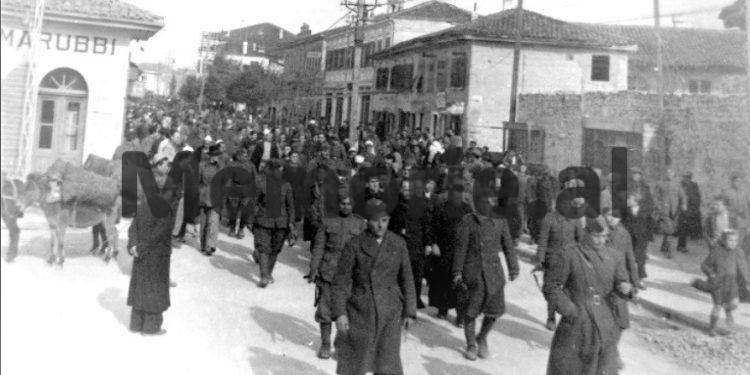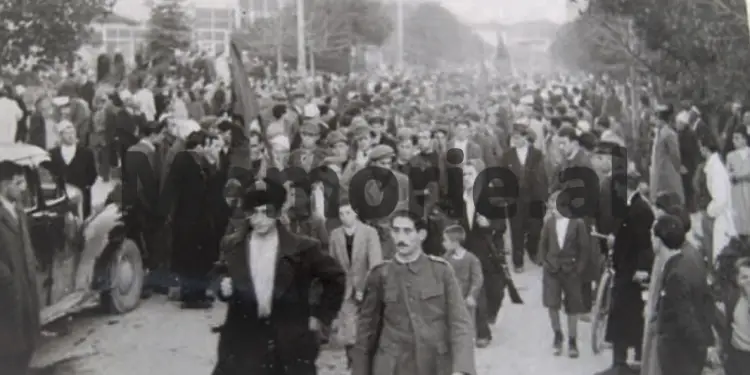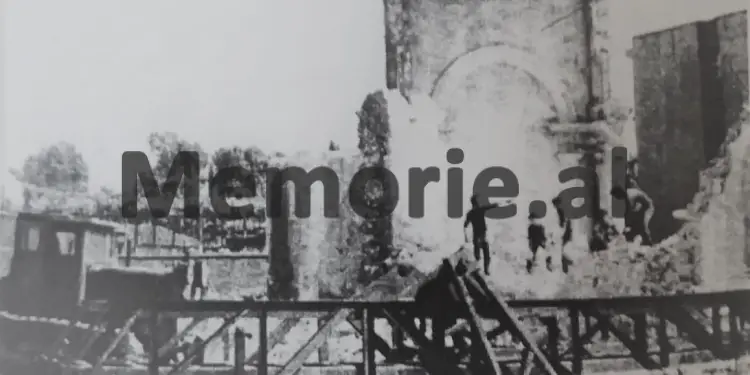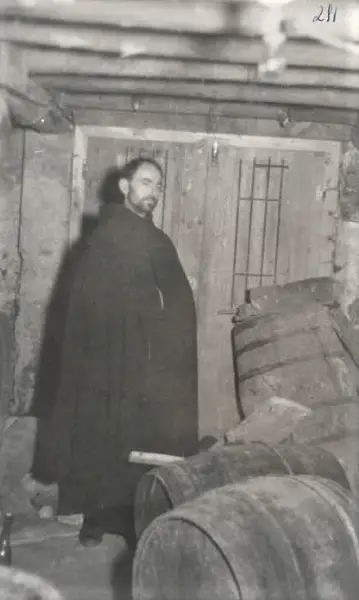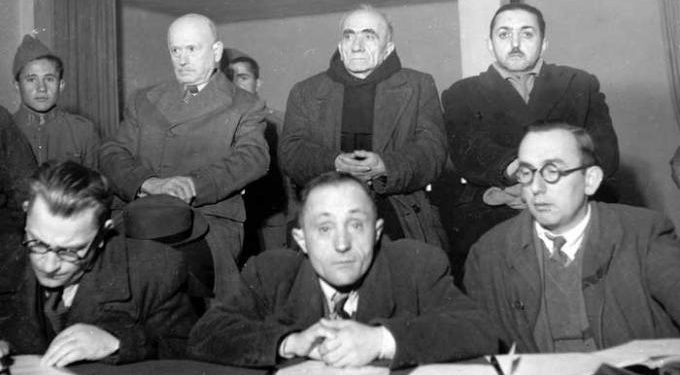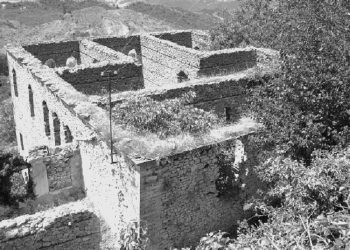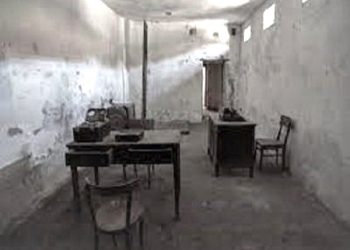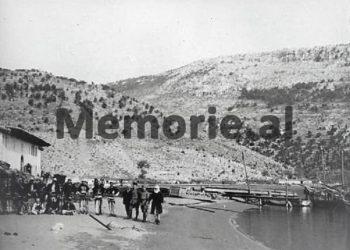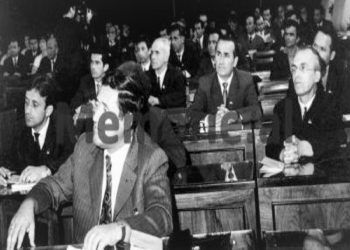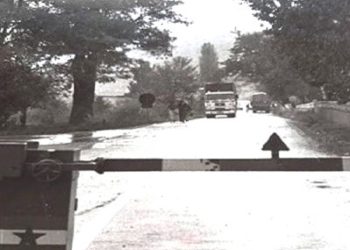By Marcel Hila
The third part
“SHKODRA DURING THE ESTABLISHMENT OF THE COMMUNIST DICTATORSHIP, 1945-1953”
Memorie.al / From the beginning of this article, I wanted to emphasize that we have to take for granted the fact that: those who came to Shkodër on November 29, 1944, were military troops who were behind the invading armies, to drive them out of this country. As the liberation is accomplished, the military force, as soon as it completes its mission, as is usually the case everywhere, must be demobilized and its men sent to their homes. But this did not happen to us!
Continues from last issue
Isn’t it for the ‘Book of Records’ the fact that for a city with only 35,000 inhabitants, (such as Shkodra), three buildings have been made available for the Military Court, because there is a lot of work, a lot of punishments to be given and halls are not enough. One at Doctor Prela’s house, which is taken out and hidden in the main street, like many others. The lower floor is suitable as a courtroom, while above, Mustafa Iliazi, the president of the military court, a partisan from the villages of Tepelena, has his office. He has given so many death sentences in Shkodër! The other office, the one opposite, is taken by Shaban Dautaj, the secretary of the Court. But another Court like building is the one that is taken to the owner of the Oil-Soap Factory, Mr. Tef Pogu, in Dugajët e Reja.
It is the place where death sentences will be given. The Assembly of the Franciscan Friars, who, expelled because of the accusation of bringing weapons into the church, became the punishment room of the Military Court of the Shkodër Military District. The entire gigantic building is taken and what used to be the printing press is adapted as a courtroom, where, as Father Zef Pllumi tells, the trial of those convicted for bringing weapons into the church took place and where three death sentences were given, many sentences with life imprisonment and many other punishments.
If the Shkodër District, but also the Shkodër Municipality would enter into a research work, they should use the survey, the questionnaire, for all these aspects that I have mentioned so far. In the case of any suffering and injustice, I believe that grandparents and parents have shown them to be so careful that they transmit their pain to their grandchildren and that they keep it all in their memory. Here, I bring an example. Years ago, in 1995, a respected professor of the University of Shkodra, Mr. Simon Pepa, who is no longer living, one day, while he was going home, he began to look at the houses of his street with a special eye. He started counting that in this one here, one has spent twenty years in prison, in this one here, the other seventeen years in prison, in this other one, twenty-two years in prison, here there is a shot.
And gathered, in the following days, accurate information about all those families that had suffered. In a single alley, he got 417 years in prison and five shootings. What if this method was applied to the entire city of Shkodra? Centuries and centuries of prison would come out. But I want to make a proposal here, which the Municipality of Shkodër can implement very well. As we remember once, in the years of our youth, the regime had filled the city with plaques, saying that here was a base of the National Liberation War; so I propose to place plaques with a special color: here lived so-and-so, who was shot, here lived so-and-so, who spent so many years in prison, here another plaque, which shows that a family lived in this place, which has been interned.
This house here was seized and became the investigator, this one here, was robbed and became the residence of high hierarchs. And if the tile had a special color, varak yellow, or blue, or red, that catches the eye, I am sure that the whole of Shkodra would be full of these tiles. And it would be one of the most special cities in the world. I don’t know another that would be similar to him. Therefore, a historical archeology must be built for all these topics. This, as soon as possible, because there is still a witness alive.
Scientific archeology has succeeded in reconstructing civilizations buried thousands of years ago. We have the opportunity to reconstruct, through facts, evidence of objects, events that happened not many years ago, but now close, and which have a unique value, and with the contribution of all those who know something and who are willing, we can becomes a completely special thing, a model for other cities of Albania, if they want to follow the example of this initiative.
But today, we have the opportunity to recognize the faces of the beasts of that time, as well as the martyrs. Thanks to the computerization made by Fototeka Marubi, just enter the name and there we have them. Why this? Surprisingly, all the demons had a penchant for puffing and showing off in front of the camera. The archive is full of photos of these sadists, who appear on celluloid with the most disgusting and disgusting poses. It is worth a collection of them, with Zoi Themeli at the head, with Nesti Kopal, with Josifi Pashko, Vaskë Koleci, Lilo Zeneli, Xhemal Selimi, Fadil Kapisizin, Česk Shoshi, Aranit Çela and others, that I am not wasting time here mention!
Why was this area chosen? Why was it designed to hit Shkodra? Is it true what you said at the beginning of the description, that Shkodra…?! But why did the regime choose him to hit him? Like that boxer who puts the opponent in a corner of the ring and shoots him mercilessly, the regime also targeted him and hit him in the cruelest way! Because Shkodra and its surrounding area did not accept this destructive invasion, did not accept that the violence was called liberation and tried to react from the beginning. Yes, he reacted, and they didn’t even accept Shkodra’s reaction! For this I have chosen a comparison: Vandë.
Many of the readers who have occasion to look at this writing, I am quite sure, know of whom I speak: of that province in Western France which opposed the French Revolution, which rose in arms to defend the institutions, the King, their freedom, the right to believe that the revolution abolished, and for that he suffered severely. They protested against the increase in taxes, against the recruitment of men into the army, because the revolution had opened war fronts everywhere, with European countries, and the ranks had to be filled with soldiers. To all this, they objected. The answer was not long in coming. Terrible violence was used, massacres were carried out on the defenseless population, and a veritable genocide was carried out.
French archaeologists have continued to discover mass graves, in communal pits, of women, children, and old people buried after they had been shot dead. Some time ago, one such was discovered. Vandeja had, in addition to the criminal revolutionaries, also an excellent feather that spoke for him, an indisputable genius of world literature: Viktor Hygonë. I say this to show that even the brightest minds experience incredible confusion. This is what Hygoi says in his book “Year 93, that lover of the ideas of the French revolution, who remembered that socialism was a development of them”. What can we say to this genius mind, which collapses so badly?
To answer you, I asked the help of the Russian genius, Alexander Soxhenic, (Nobel prize for literature in 1970), the author of the book of more than 2000 pages “Gualg Archipelago” and “Cancer Pavilion” as well as author multi-page study of Russian and world communism. I relied on what this colossus said precisely about Vandena, in 1993, two centuries after the events, when he was called to France to be present at the erection of the monument raised in honor of the victims of the revolution. And since the ideas of this last colossus are so opposite to those of the French genius, we are confronting them. I am not afraid to be misunderstood here, because Hygoi himself, in his novel “Les Miserables”, says that: “Only equals have the right to be judged!”.
I think that Solzhenitsyn is more than equal to Hygoin in terms of genius and the field of literature, but he surpasses him as more unfortunate or fortunate, because he spent the age of the devil, not at the writing desk, but in the terrible prisons, in the Gulag. Hygoi predicts a future happiness that is not at all clear, Solzhenitsyn testifies to the horror of the experienced and disappointing reality of socialism. Here’s what the great Russian says: “Vandea is that area destined to become a victim of a murderous regime, because it best embodies what the revolution hates: it is hated for the values it carries, for the faith it has, for the freedom it has holy and refuses to be touched. The revolution oppressed and humiliated to the end the peasants who opposed it!”.
“What did the revolution bring to the Vendées?” – The great writer, winner of the “Nobel” prize, continues with his question. – “Only destruction, because every revolution breaks out in people the instincts of the most basic barbarism, the dark forces of greed, ferocity and hatred. The Vendeans had understood this very well and for this they paid a heavy tribute”! – He concludes.
“Modern times have taken away the halo that surrounded the head of the ‘French Revolution.’ Reflecting on the disasters, men have come to the conclusion that revolutions destroy the organic character of a society and the natural course of life. Revolution annihilates the best elements of the population, leaving a free field for the action of the worst and which, in the countries where it generally plagues, causes thousands of victims. In revolutions, poverty spreads fearfully and a fearful degradation of the population takes place”!
The word revolution itself comes from Latin and means “turning back”, “return”, “a trial”, and at best an overturn. Some slightly enviable meanings. A revolution alone cannot be considered a thing of value. No country should be congratulated for a “great revolution”. The revolution, wherever it has broken out, has thrown the people of their country into the abyss of loss and destruction. How dearly did the revolution pay the countries where it knocked on the door and entered by force? And what price we paid in our communist revolution!
The cruel practices of the French revolution were also applied to the body of our nation by the Albanian communists, only that their methods were far crueler than those of the Jacobins.
Vendée was a great uprising with endless casualties. Russia had its own Vanda: the ‘Tambov Uprising’ in 1920-1921, the Western Siberian uprisings of 1921. Peasants with scythes in hand who rose up in revolt took to the streets of Tambov, but were mowed down by machine guns.
These uprisings were repeated for eleven months in a row, even though the communists suppressed them all, even using airplanes for bombing and throwing poison gas and tanks, shooting people and houses indiscriminately, taking hostages of the families of the insurgents. The Cossacks of Orale, Don, Kuban, and Tersk also resisted, but it was a resistance drowned in blood. Vendée was repeated in Poland, in Krakow and in Dansk; Hungary had its share in the events of the 1956 revolt; East Germany’s Vendée took place in 1948, but was destroyed by machine guns. Vendea was also repeated in Romania, Siubi and Timoshoara. Even the Albanians of Kosovo, from the beginning, in 1944-1945, had their “Vandena” full of blood and crimes. Vandea was repeated everywhere. There is no place where communism has plagued that does not have its own “Vandena”.
Even we Albanians have had our ‘Vandena’. The entire area of Shkodra and the city itself created their own ‘Vandena’. The Uprising of Prenk Cal, Llesh Marashi, the ‘Postribe Uprising’, the wars in the mountains, the ‘Mountain Committee’, the youth groups of various high school students, the ‘Albanian Unity’, the ‘Albanian Effort’ and many others, are all elements with DNA similar to the French Vande. All of them, like her, are drowned in blood, sentenced to be shot, rot in prisons, mutilated in draconian measures. All with the low accusation: you are reactionary. But what does reactionary mean? Re-action.
So to turn the action back in time, to correct the actions performed, to heal the institutions, with the aim of a positive effect on society. So, as in the Vendée effort, they were all attempts to bring trampled justice to the place, when a dark force has defiled them. “Reaction” – says Solzhenitsyn, – “carries a great sanctity of action. It is justice that has fallen down and needs to be given a hand to raise it up”.
How good it would be if a big monument was erected in Shkodër, where all the high school student groups were commemorated, the countless young people who bravely and heroically contributed to the resistance of such a reaction, the innocent victims, the martyrs, the clergy, the resistance, our Vendees.
Let us now take a step forward and ask the question: who is the revolution attacking? Who are his opponents? The best answer is in the opening lines of the invitation: those people this city had who embodied values.
We must never forget that revolution rages against faith in God. Atheism is a constant feature of it, everywhere. A French intellectual, who was in China in the years when the Communists were getting ready to take power, found out that in addition to the Marxist-Leninist revolutionary theory of taking power by force, the Maoists also taught Darwin’s theory. He was greatly impressed by the fact that they were more proud to be called sons of monkeys than sons of God!
But why are these massacres on such a large scale, why are they carried out in such large numbers? Why the need for so many victims? Take the most vile characters of world literature, remember the scheming Iago, who leads people to murder, do not forget Macbeth with his wife, remember Dante with his Inferno. Iago is only a masquerader, Macbeth a criminal. His victims are few, not even ten. He is driven by the fear of becoming a criminal because he is afraid of losing the throne. But his crimes are childish; the devils of Dante’s Inferno are fallen angels, who roam the dark abysses and whom Dante and Virgil see flying over their heads, without doing any harm to the special visitors.
These peaks of negativity embodied in artistic images are garden roses if you compare them to what our liberators who came to power caused. But why are these people like that, which plan up to 14,000 arrests and demand 4,000 shootings for just one area of a city? Because here we are not dealing with a love intrigue where Iago serves, and it is not a question of a king trying to protect his chair and having to eliminate his rival, but it is something else, more terrible: it is ideology. It is the atomic bomb, with a wide range of action and devastating shock waves, with the most deceptive force of the pretense of doing justice. Memorie.al
The next issue follows




